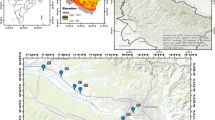Abstract
A new four-step hierarchy method was constructed and applied to evaluate the groundwater quality and pollution of the Dagujia River Basin. The assessment index system is divided into four types: field test indices, common inorganic chemical indices, inorganic toxicology indices, and trace organic indices. Background values of common inorganic chemical indices and inorganic toxicology indices were estimated with the cumulative-probability curve method, and the results showed that the background values of Mg2+ (51.1 mg L−1), total hardness (TH) (509.4 mg L−1), and NO3 − (182.4 mg L−1) are all higher than the corresponding grade III values of Quality Standard for Groundwater, indicating that they were poor indicators and therefore were not included in the groundwater quality assessment. The quality assessment results displayed that the field test indices were mainly classified as grade II, accounting for 60.87% of wells sampled. The indices of common inorganic chemical and inorganic toxicology were both mostly in the range of grade III, whereas the trace organic indices were predominantly classified as grade I. The variabilities and excess ratios of the indices were also calculated and evaluated. Spatial distributions showed that the groundwater with poor quality indices was mainly located in the northeast of the basin, which was well-connected with seawater intrusion. Additionally, the pollution assessment revealed that groundwater in well 44 was classified as “moderately polluted,” wells 5 and 8 were “lightly polluted,” and other wells were classified as “unpolluted.”





Similar content being viewed by others
References
Edmunds, W. M., Shand, P., Hart, P., & Ward, R. S. (2003). The natural (baseline) quality of groundwater: A UK pilot study. Science of the Total Environment, 310(1–3), 25–35. https://doi.org/10.1016/S0048-9697(02)00620-4.
El Tabach, E., Lancelot, L., Shahrour, I., & Najjar, Y. (2007). Use of artificial neural network simulation metamodelling to assess groundwater contamination in a road project. Mathematical and Computer Modelling, 45(7–8), 766–776. https://doi.org/10.1016/j.mcm.2006.07.020.
Foster, S., Garduno, H., Kemper, K., Ghodeif, K. (2006). Groundwater quality protection, Definition of strategy and priorities setting (in Arabic). Wallingford, UK:Global Water Partnership Associate Program.
Gemitzi, A., Petalas, C., Tsihrintzis, V. A., & Pisinaras, V. (2006). Assessment of groundwater vulnerability to pollution: A combination of GIS, fuzzy logic and decision making techniques. [journal article]. Environmental Geology, 49(5), 653–673. https://doi.org/10.1007/s00254-005-0104-1.
GrouPe scientifique de l’eau. (2003). Fiches synthèses sur l’eau potable et la santé humaine, Institut national de santé publique du Québec. http://inspq.qc.ca/pdf/publications/198CartableEau/ColiformesTotaux.pdf (consultation le 03/01/2012).
Guo, X. (2005). Water environment assessment and protection measures of Dagujia River valley. Journal of Yantai University (Natural Science and Engineering Edition), 18(4), 308–312.
Han, Y., & Hu, X. (2009). Analysis on runoff variation characteristics in the typical river basin of hilly area in Shandong peninsula. Research of Soil and Water Conservation, 16(4), 220–224.
Han, Z., Ma, H., Shi, G., He, L., Wei, L., & Shi, Q. (2016). A review of groundwater contamination near municipal solid waste landfill sites in China. Science of the Total Environment, 569–570, 1255–1264. https://doi.org/10.1016/j.scitotenv.2016.06.201.
Kumar, M., Ramanathan, A. L., Tripathi, R., Farswan, S., Kumar, D., & Bhattacharya, P. (2017). A study of trace element contamination using multivariate statistical techniques and health risk assessment in groundwater of Chhaprola Industrial Area, Gautam Buddha Nagar, Uttar Pradesh, India. Chemosphere, 166, 135–145. https://doi.org/10.1016/j.chemosphere.2016.09.086.
Kuo, Y.-M., Liu, C.-W., & Lin, K.-H. (2004). Evaluation of the ability of an artificial neural network model to assess the variation of groundwater quality in an area of blackfoot disease in Taiwan. Water Research, 38(1), 148–158. https://doi.org/10.1016/j.watres.2003.09.026.
Liu, C.-W., Lin, K.-H., & Kuo, Y.-M. (2003). Application of factor analysis in the assessment of groundwater quality in a blackfoot disease area in Taiwan. Science of the Total Environment, 313(1), 77–89. https://doi.org/10.1016/S0048-9697(02)00683-6.
Liu, D., Liu, X., Liu, J., & Wei, X. (2007). Analyses of variation characteristics and abruptness of temperature-precipitation of typical basin in Jiaodong Peninsula Hilly Watersheda—case study of the Dagujia River. China Rural Water and Hydropower, 1 (10), 13–17.
Mehra, M., Oinam, B., & Singh, C. K. (2016). Integrated assessment of groundwater for agricultural use in Mewat District of Haryana, India using geographical information system (GIS). Journal of the Indian Society of Remote Sensing, 44(5), 747–758. https://doi.org/10.1007/s12524-015-0541-6.
Mohamad, S., Abbass, M., & Eisa, A. (2016). Groundwater quality modeling with a small data set. Ground Water, 54(1), 115–120.
Reimann, C., Filzmoser, P., & Garrett, R. G. (2005). Background and threshold: Critical comparison of methods of determination. Science of the Total Environment, 346(1–3), 1–16. https://doi.org/10.1016/j.scitotenv.2004.11.023.
Runnells, D. D., Dupon, D. P., Jones, R. L., & Cline, D. J. (1998). Determination of background chemistry of water at mining and milling sites, Salt Lake Valley, Utah, USA. Proceedings of the Water-Rock Interaction, 997–1000.
Shand, P., & Frengstad, B. (2001). Baseline groundwater quality: a comparison of selected British and Norwegian aquifers. British Geological Survey pp. 92. http://nora.nerc.ac.uk/id/eprint/12662/.
Shand, P., Edmunds, W. M., Lawrence, A. R., Smedley, P. L., & Burke, S. (2007). The natural (baseline) quality of groundwater in England and Wales. Mycologia, 94(3), 411–420.
World Health Organization. (2011a). Background document for development of WHO Guidelines for Drinking-water. Quality, 37(4)227–231.
World Health Organization. (2011b). Guidelines for Drinking-water Quality 4th Ed. World Health Organization.
Xu, Z., He, J., Ma, W., Zeng, Y., Wen-jie, M., & Ying, Z. (2016). A renovated comprehensive evaluation method for groundwater pollution index classification. Journal of Safety and Environment (In Chinese), 16(1), 342–347.
Ying, L., Hou, X., Lu, X., & Han, L. (2011). Long-term impacts of land use change on non-point source pollution in the Dagujia River Watershed of Shandong Peninsula. International Symposium on Knowledge Acquisition and Modeling, 482–486.
Acknowledgments
This work is supported by the Shandong Province Geological exploration projects (No. 201345) and the Scientific Research Funds for Yong Scholars of Weifang University of Science and Technology (No. sdlgy2013w003).
Author information
Authors and Affiliations
Corresponding author
Rights and permissions
About this article
Cite this article
Zhu, H., Ren, X. & Liu, Z. A new four-step hierarchy method for combined assessment of groundwater quality and pollution. Environ Monit Assess 190, 50 (2018). https://doi.org/10.1007/s10661-017-6403-7
Received:
Accepted:
Published:
DOI: https://doi.org/10.1007/s10661-017-6403-7




